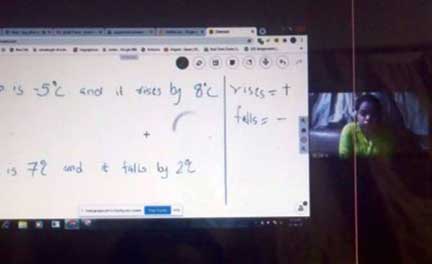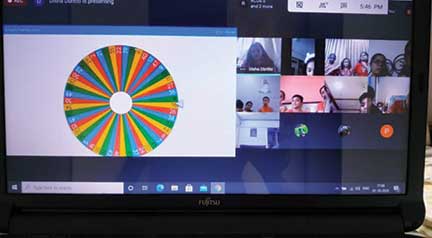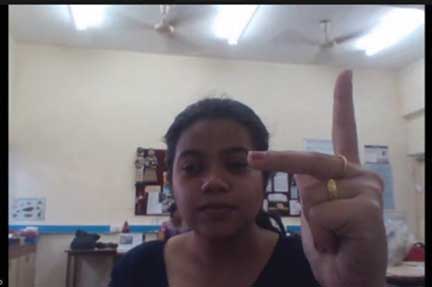Disha Dbritto
The National Education Policy (NEP) 2020 emphasizes multi-disciplinary and holistic education, which includes leveraging the advantages of technology and expanding on it. The policymakers’ goal in terms of technology use was to reform and digitize the country’s education. To bring this vision to reality, a minimum pre-requisite is the availability of internet connection across the remotest locations of our country and a robust infrastructure which can support and promote this. While one might agree that digital learning needs to be supplemented with a teacher practitioner who has some basic technical know-how, there are other issues emerging out of the content that is being taught to children in the classroom. These issues came to the fore when I was teaching children online during the pandemic.
The pandemic year
When the world went into lockdown, I was teaching mathematics and physics in an international school. To address the educational needs of young minds, traditional live classes were converted into online classes using Google Classrooms and Zoom Meetings. Adapting to this change was certainly not an easy task for me. Though the idea of “Working From Home” seemed appealing and exciting, it was actually very difficult to execute a teaching-learning environment for physics and mathematics. In this article I share some interesting personal experiences from my physics classes as we transitioned from an offline to an online world.
A mix of live and recorded sessions
It started with initiating and introducing teachers to platforms like Zoom and Google Classrooms. This was followed by training parents (who would assist their children at home) on how to use these platforms. Initially, I began with uploading a few recorded sessions. This in itself was a tricky task for I had to teach pretending that I was talking to students in real time. It was not uncommon to end up spending two hours to record a 40-minute session! Even though I was familiar with these platforms, there were numerous goof ups from forgetting to turn on the record button to shooting multiple retakes owing to errors. Over time, I realized that the recorded sessions were turning out to be monotonous for they deprived students of opportunities to engage and question with me. It was then that I decided to take the leap and move to live lectures. But this came with its own set of disadvantages!

In the first few days, the live sessions felt engaging and provided the feeling of being in an actual classroom. As they simulated a real classroom with about 30 students and a teacher present (albeit online), students were happy to see the faces of their classmates. But, all this liveliness was short-lived. Soon enough, we had to grapple with issues like: unable to keep video cameras on due to excessive data consumption, bandwidth issues, space crunch in the home, in addition to all losing interest in the online sessions. This would entail students purposely turning their video cameras off, not unmute to answer questions, etc. So every day seemed to be a challenge. I had to constantly change my teaching approach to ensure that students were able to engage in meaningful discussions and understand concepts.
Teaching physics
Physics is all about understanding things happening in the real world. Demonstrations and experimentation play a major role in conceptual understanding in physics classrooms. But online teaching during the pandemic drastically limited the wonder and visual impact of classroom demonstrations. The physics classes had no hands-on experiences and this made it very difficult to connect theory with real world problems. I started performing live demonstrations for those topics which could easily fit into the field of view of the web camera (and that are picked up clearly by the microphone, if sound is involved). Live demonstrations on topics related to chapters of heat and light seemed exciting for students as they could relate it with their daily life experiences and were able to analyze the science behind it.

For instance, to explain convection currents in the water, I took two glasses of different sizes. In the small glass, I added hot water with a coloured dye and in the larger one I put room temperature water with no dye. I then sealed the small glass with aluminium foil and made a small hole in the foil in the center. This set-up was carefully placed inside the large glass containing normal water. Within a few minutes, students were able to see the stream of coloured water rising up from the submerged small glass. This stream would rise and then move downwards after cooling. So in this way, I started to do demonstrations where observations could be made even in the online format. This helped in engaging the students.
However, gauging students’ level of understanding in the online class was a challenge. I couldn’t pick up their non-verbal cues or gestures in the online mode as most of the time the students were muted or had their videos turned off. Further, many students were not comfortable talking or asking questions in the presence of the whole class (an issue commonly noticed even in regular classrooms). To address this, I also dabbled with breakout rooms so as to provide a comfort zone for students where they could collaborate on group presentations. Breakout rooms are a way to divide students into smaller groups so they can work on their assignment. Zoom and Google Meet both offer this in their settings and activity menu respectively. A teacher can assign students into breakout rooms and individually visit each room to check on students and engage with their questions and doubts. These breakout rooms turned out to be a good way to build interaction among the students and it also helped me gauge their concept knowledge as they were more vocal in the smaller groups.
Unexpected challenges of the online format
I remember this one physics class in particular. I had started explaining the topic of electromagnetism. In the beginning, students found it fascinating to know how a current carrying conductor produces a magnetic field around it and the interconnection of the electric and magnetic field with each other. But teaching Fleming’s left hand and right hand rule to find out the direction of force (for left hand rule) and direction of induced current (for right hand rule) was a tormenting episode as one needs to carefully understand the direction in which the fingers are pointing. While teaching this in an online class, lateral inversion of the images takes place, flipping the left and right sides of images on some virtual platforms. This caused confusion not just for me, but also the students while viewing their own image on the screen to understand the directions. I resorted to using simulations to teach these topics. This made the visualization part a bit easier for students but not very satisfactory.
Another problem which I realized during the course of online teaching was when we were dealing with topics related to vectors. In vector addition with parallelogram rule; each arrow along with the direction specifies the force acting on an object and the length of the arrow gives the magnitude of force. The diagonal of the parallelogram constructed is the resultant force acting on an object. I started with drawing the diagrams on the Zoom whiteboard screen. As these were rough diagrams with no proper scale bars, there was variation on how students viewed it on their online devices which were phones, laptops, or tabs. Depending on the screen size, the length of the arrows changed from one device to another which led to vast variation in students’ answers and thus the concept that the length of the arrow specified magnitude of force was not quite clear to the students.
Just got used to online and then schools became offline again!
Although it seemed difficult at first, after getting a gradual hold of working with online teaching tools and apps like Google Classroom, Mathpad, Geogebra, Kahoot, Desmos, Khan Academy, Phet Simulations, and oPhysics, I felt that the overall classroom engagement improved a little. My own learning involved going through numerous tutorial videos to understand how I can use these apps for better teaching-learning experiences. Just as I got comfortable, schools reopened their doors and started welcoming their students! It felt really great that life began to feel ‘normal’ again. I must also acknowledge that both teachers and students did end up gaining a new skill set which can continue to be useful for both, even if schools are running in offline modes. For example, now many teachers continue to assign homework or project work using Google Classroom, use simulations for specific topics, or use Kahoot and Khan Academy tests for formative assessments.

The bigger picture and questions that remain unanswered
This entire experience made me think more deeply about the whole issue of online teaching, student engagement and NEP’s vision of digital education. Though I worked in an urban area where one can say students and teachers have relatively more access and exposure to good infrastructure and resources than rural areas, the students and I spent a considerable amount of time learning the nuances of these digital technologies. The pandemic forced us into a path of learning where we ended up developing new skills. I must admit, this steep learning curve with respect to using these online tools was necessitated by our need to deal with the prevailing conditions! But that left me with a pressing question, a pandemic cannot always be the reason for moving towards new horizons of learning now… can it?
How well are we prepared to translate the vision of NEP 2020 towards the use of technology in education into reality? Have we actually considered the teaching difficulties that may emerge from the content being taught as illustrated in the examples shared above? What steps would be needed to address these difficulties? One needs to ponder on these issues as well!
Acknowledgments: This is my first ever attempt to write about my teaching experience. So I am grateful to Adithi Muralidhar for her guidance and inputs. I would also like to thank Prof. Sugra Chunawala, Dr Anisha Malhotra-Dalvi and Prof. Arnab Bhattacharya for their feedback.
Reference: National Education Policy: https://www.education.gov.in/sites/upload_files/mhrd/files/NEP_Final_English_0.pdf
The author works at Homi Bhabha Centre for Science Education, TIFR, Mumbai. She can be reached at disha@hbcse.tifr.res.in.
